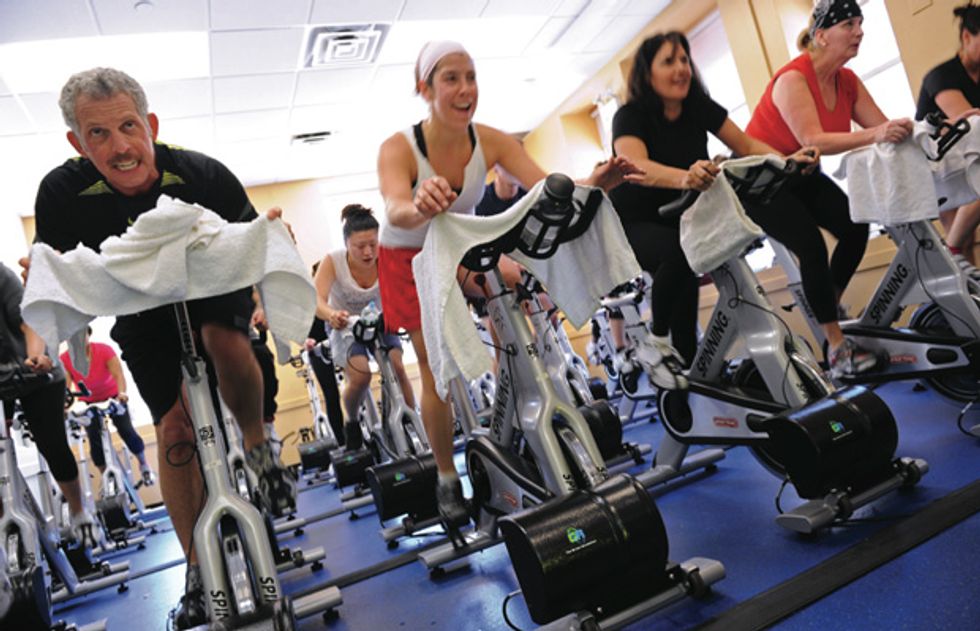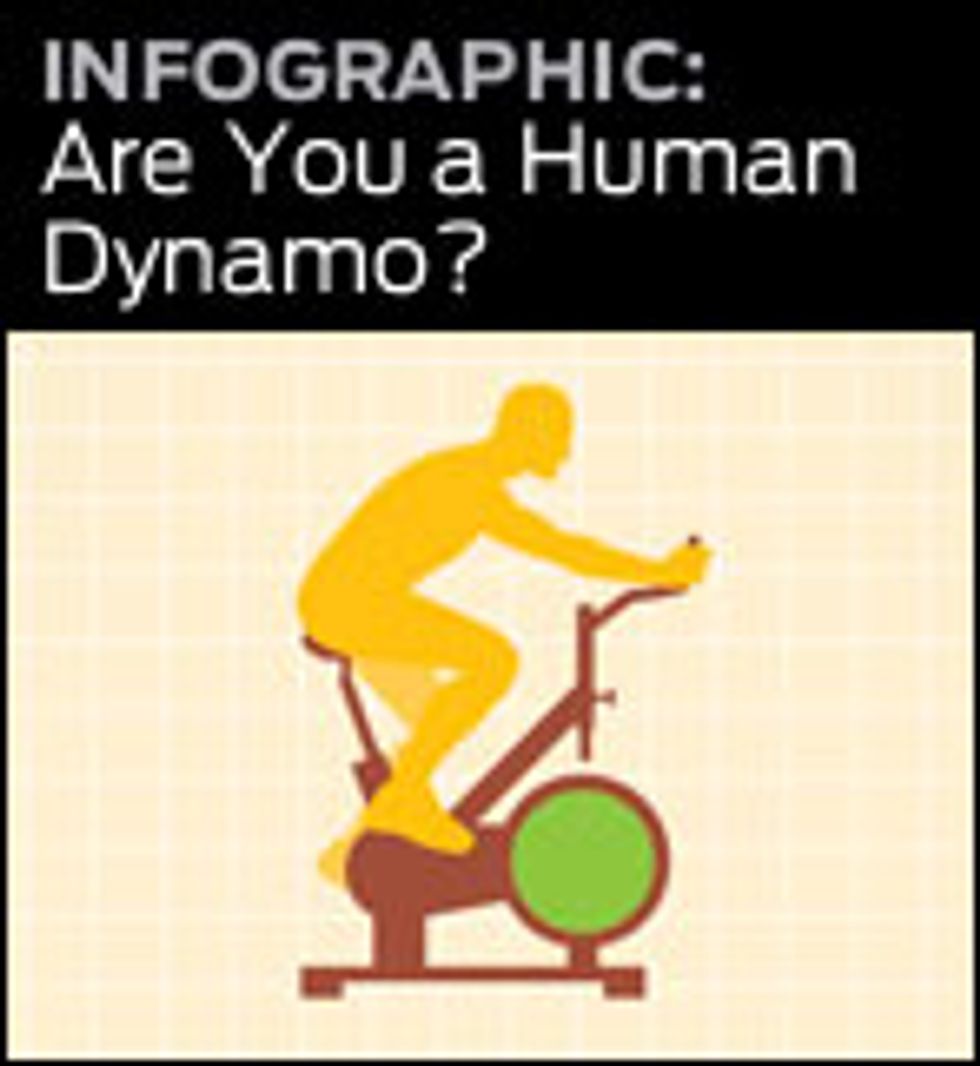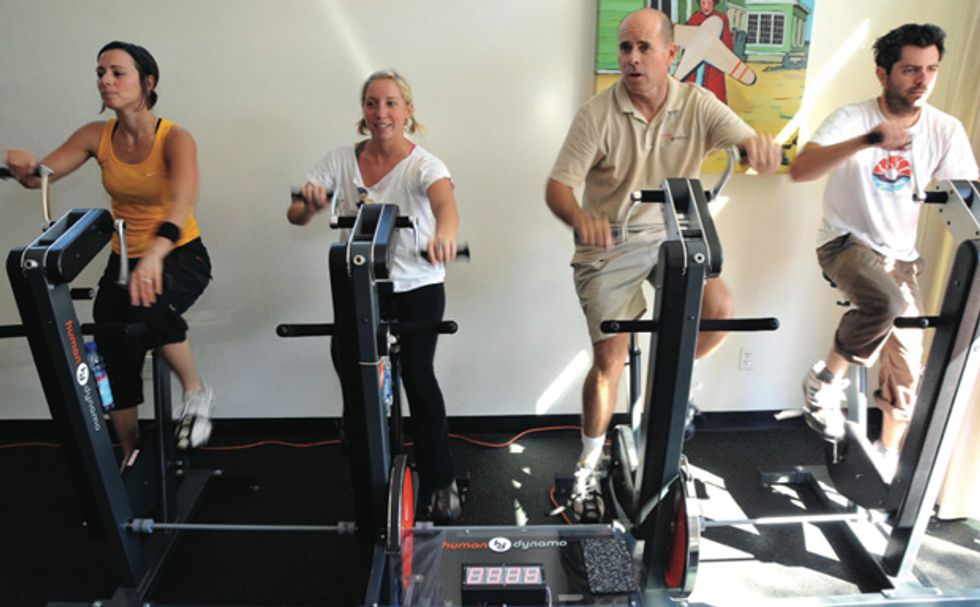These Exercise Machines Turn Your Sweat Into Electricity
Exercise equipment that generates power is the latest fad. But will the economics work out?

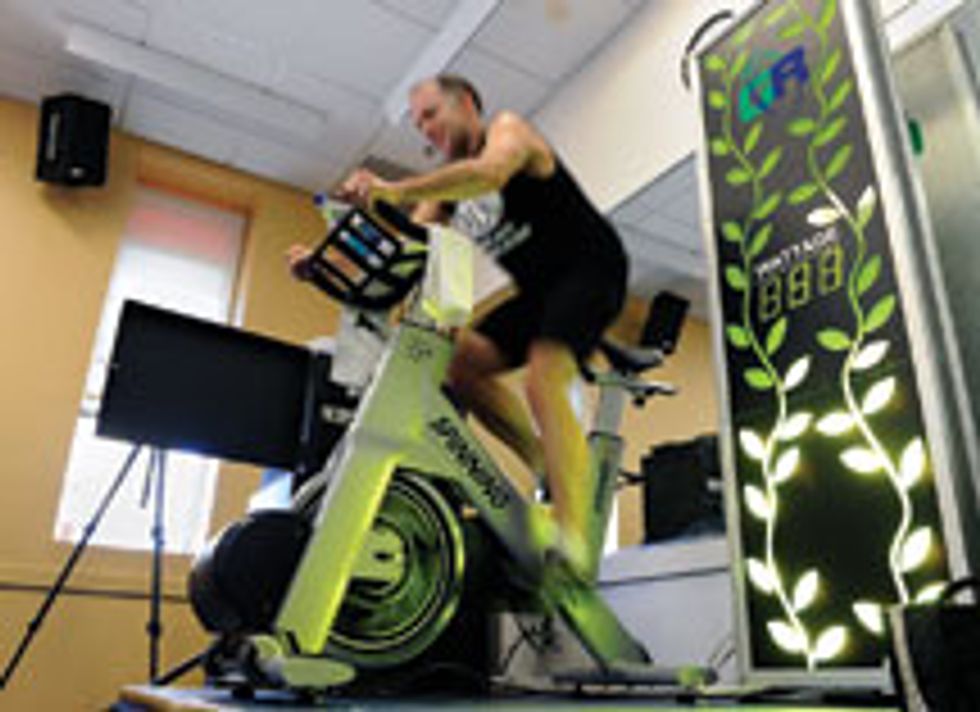
Walk into a spinning class at the New York Sports Clubs' facility on Eighth Avenue and West 23rd Street in Manhattan and you'll find 20 sweaty people furiously pedaling their stationary bikes. Look closely and you'll notice something unusual about this workout: Each of the bikes is attached to a black box with wires running out of it. The box is a compact generator that converts the motion of the wheels into electricity, which is then fed into the power grid, offsetting some of the club's energy use. For these gym-goers, it's not just about their cardio fitness; their sweat is helping to make the planet a bit greener.
By adopting power-producing exercise machines in this way, gyms can promote themselves as environmentally friendly and also reduce their electric bills. At least three start-ups in the United States are now selling equipment to retrofit aerobic machines—stationary bicycles, elliptical trainers, and steppers—into electricity-generating gear. These companies have already converted several hundred machines at dozens of U.S. health clubs and university gyms.
The reality, though, is that this technology faces major hurdles before it can go mainstream. For one thing, the economics aren't very enticing. The energy output from a single exercise machine is quite small: Unless you're Lance Armstrong, you might be able to power a ceiling fan while spinning a stationary bike, but not much more. So a gym might have to wait decades to recover the money it spent converting its exercise machines to generate electricity. What's more, the energy output of these machines is so low that the environmental benefits they provide are scant. So don't expect that fitness enthusiasts pedaling stationary bikes are going to free the United States from its addiction to fossil fuels.
Backers of the technology respond by comparing the current cost of these machines with that of technologies like compact fluorescent bulbs or solar and wind power, which many people doubted would ever take off. They claim it's only a matter of time until every exercise machine comes equipped with a generator. And with some 30 000 gyms in the United States, that would mean millions of machines—and many more in people's homes—whose combined energy would then be appreciable.
“Stationary bikes create resistance, and through this friction, heat is produced,” says Jay Whelan, cofounder of the Green Revolution, in Ridgefield, Conn., the company that converted the spinning bikes at the NYSC in Manhattan. “The industrial engineer in me said, 'What a waste! There's got to be a way to capture and use this energy.' ”
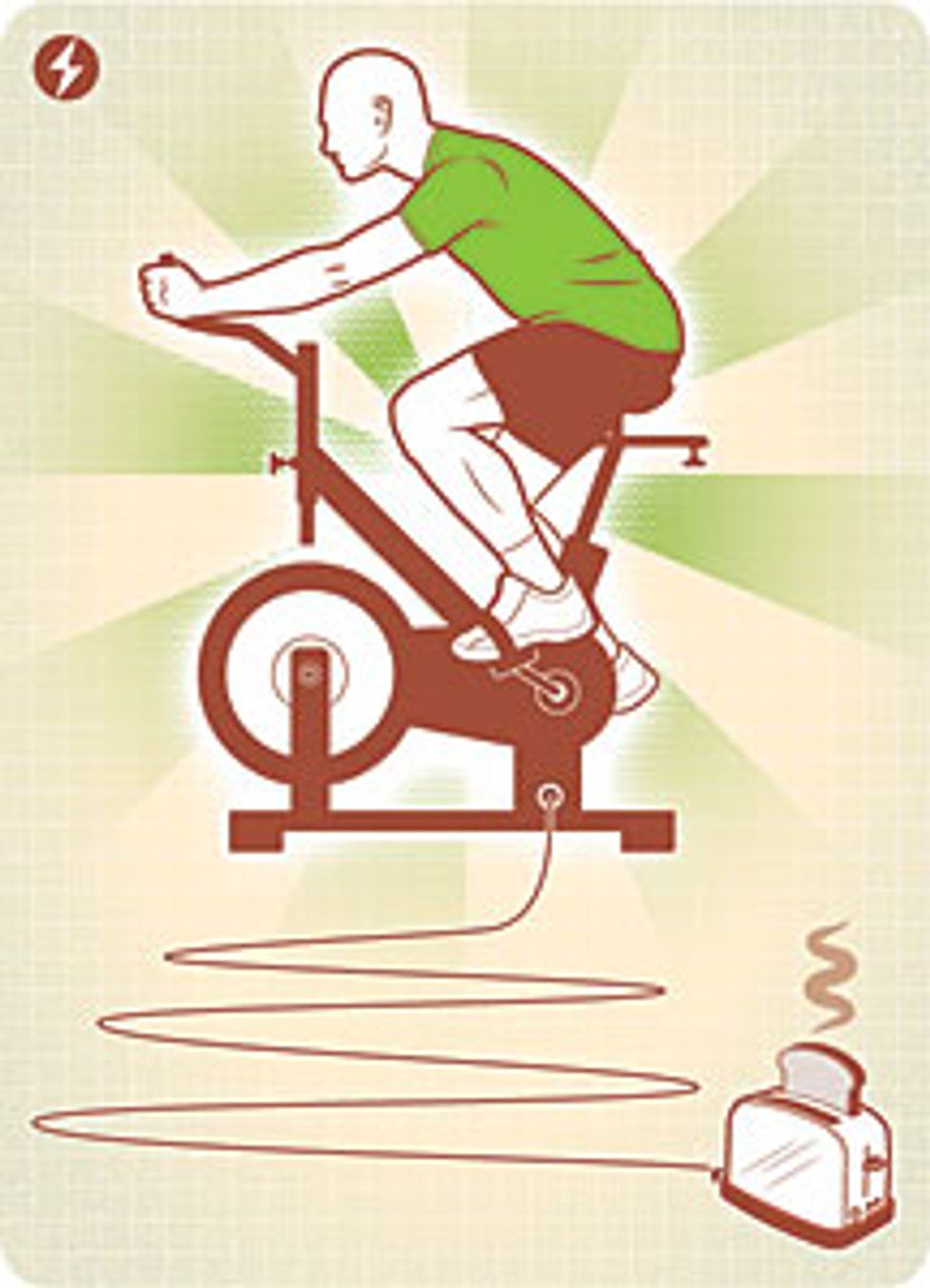
Although the basic idea of attaching a generator to exercise equipment is many decades old, the press started lavishing attention on this concept four years ago, after a Hong Kong gym called California Fitness rigged 18 exercise machines to charge a battery and power fluorescent lights. Since then, three companies in the United States have been working hard to market the technology, each taking a slightly different approach.
In 2007, Hudson Harr, then a 21-year-old graduate of the University of Florida with degrees in electrical and mechanical engineering, spent all the money he had amassing a collection of used elliptical machines and electrical parts. Transforming his mother's house into his laboratory, he began tearing the equipment apart. What he found is that some elliptical models already had small DC generators inside. These power the monitoring console and also serve to increase the amount of resistance the user feels when exercising. That's because the current generated creates a magnetic force that opposes the motion that creates this current. By adjusting the amount of current created, the user can vary the resistance he or she feels.
Normally, the generator uses a bank of resistors to dissipate the energy it produces. Harr figured that he could get rid of the resistors and put that power to work. “Essentially, we remove the internal resistance the machine has and give it an external load, which is our equipment,” he says. Harr's strategy is to wire each elliptical machine to a central unit containing an inverter that converts the DC power generated to AC. The inverter in turn connects to the building's electrical system and ultimately feeds the grid.
Harr's lab is no longer taking up space at his mother's house. His company, ReRev, based in Clearwater, Fla., has moved into a 1400-square-meter production facility and now employs 15 people. ReRev has wired up 150 machines at more than a dozen gyms. It has installed systems at many colleges, including Drexel University, James Madison University, Oregon State University, Texas State University, and the University of Florida.
Meanwhile, the Green Revolution, the company Jay Whelan and Mark Sternberg founded in 2008, went down a different road. Instead of elliptical trainers, the two entrepreneurs focused on exercise bicycles. They started by taking an ordinary bike and propping its back wheel up on a triangular frame. Then they attached a car alternator to the wheel and hacked it to boost the amount of power it could generate, which also raised the resistance to motion it provided.
Their initial idea was to design and build entirely new exercise bikes with generators attached to them. But the owners of exercise clubs didn't want to buy all new equipment, so the two entrepreneurs decided to build a power-producing modification instead. Their module attaches directly to the bikes, feeding electricity to two 12-volt batteries wired in series. When a user starts pedaling, the batteries charge, and when they're full, the inverter kicks in and sends power to the grid, converting 24-V DC to 110-V AC.
Although the Green Revolution decided not to build custom equipment, that's exactly the approach another entrepreneur in this field has taken. Mike Taggett attended the University of Arizona, where he majored in Latin American studies. He worked as a river guide and started a business making an eyeglass retainer that he'd invented himself. At a trade show sometime in the late 1980s, he had the idea of attracting visitors to his company's booth by bringing a converted exercise machine that would generate electricity and power lights and kitchen appliances. “We made smoothies,” he recalls.
That demonstration was the seed of an idea that grew in Taggett's mind over the next two decades. A few years ago he got to work, and in 2008 he unveiled the Human Dynamo, a custom-designed power-producing stationary bike—with a twist. In addition to the usual pedals, the machine has hand cranks to provide a rigorous upper-body workout and generate even more electricity. With their sprockets chained together, the hand and leg cranks spin at the same speed to turn the bike's 45-centimeter-diameter flywheel about 300 revolutions per minute during a typical workout. A belt connects the flywheel to the generator, which spins at something like 1500 rpm.
You can connect several of Taggett's machines together to drive a single generator. He calls this configuration the Team Dynamo. “You really cut down expense and maintenance because you have one big generator and one electronics package for up to 10 machines,” he says.
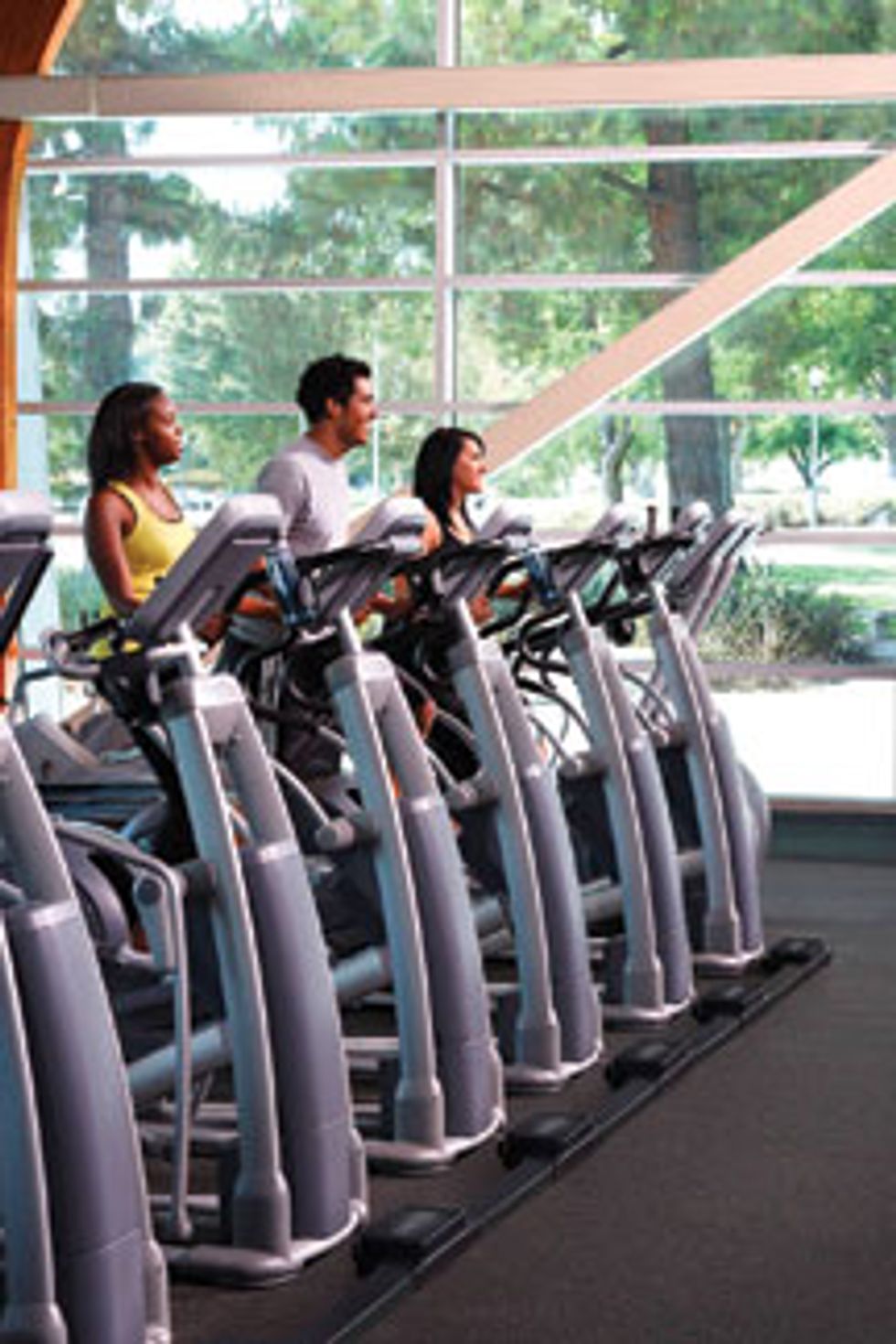
It might feel like a lot if you're generating it, but just how much energy are we talking about here? An elite cyclist can produce more than 400 watts, more than half a horsepower, for an hour or more at a stretch. But the average person, even somebody in good shape, can generate only 50 to 150 watts during an hour of strenuous exercise. If you could capture that power to produce electricity, what would it be good for? Not much, really. It could power a television set for about an hour, which might keep you entertained while you pedaled away to produce the electricity in the first place.
Still, might this be a reasonable way for a gym to offset at least some of its electricity use? Let's assume that the average piece of exercise equipment is in use 5 hours a day, 365 days a year. If each patron generates 100 watts while using it, that machine creates some 183 kilowatt-hours of electricity a year. Commercial power costs about 10 cents per kilowatt-hour on average in the United States, so the electricity produced in a year from one machine is worth about US $18 dollars.
The companies selling the retrofitted equipment say that costs vary on a case-by-case basis, depending on the kind of equipment the gym has and its electrical installation. But according to some reports, it costs a gym at least several hundred dollars—perhaps as much as $1000—to purchase the equipment or equipment modifications needed to harvest this electricity from a single exercise machine. Earning just $18 a year from it means that the initial investment would take decades to pay back. Other energy-conserving investments a gym might consider, such as installing better insulation or adding solar water heaters for the showers, typically have payback periods of several years.
So are these electricity-producing exercise machines merely a marketing gimmick, something to make gym patrons feel good about their workouts? At the moment, that would seem to be the case. Gyms that have embraced the technology say that by advertising themselves as greener than regular gyms—and gyms are notorious power hogs—they can attract environmentally conscious customers. And if enough customers choose that gym rather than another one down the street, the initial investment will pay for itself much faster.
Take the Green Microgym in Portland, Ore. Adam Boesel opened the facility in 2008 with Human Dynamo machines inside and solar panels on the roof. Boesel reports that his gym generates about 36 percent of its own electricity, saving nearly 40 000 kWh per year—although he admits that the savings come mostly from the solar panels.
“People are very receptive,” says Boesel. He even initiated a program called Burn and Earn, which rewards customers with $1 coupons—redeemable for food, beverages, clothing, and other merchandise—for every hour they operate the electricity-generating equipment. The electricity produced certainly isn't worth a dollar to him. And he'll be lucky if he's still in business when the electricity generated from the machines finally compensates for the extra money he spent on them.
But this might change in the not-too-distant future, if the companies selling retrofitted equipment can ramp up volume and bring costs down. Or if the mainstream manufacturers of exercise machines catch the wave and add an electricity-generation option to their products without charging a large premium for it. If including that feature ups the price only $100 or so—a reasonable prospect given the very minor alterations needed—the payback period would rival that of many other conservation measures.
Boesel can't wait. “I hope this technology is in every piece of equipment in 10 or 15 years,” he says. “A few watts here and there from all of us as we sweat may add up to something significant.”
This article originally appeared in print as “Turning Sweat into Watts.”
About the Author
Tom Gibson is a consulting mechanical engineer specializing in renewable energy and recycling and a freelance writer covering technology. He's also an avid mountain biker and laments that he didn't get to try out the electricity-producing exercise bicycles he describes in “Turning Sweat Into Watts.” “But I did take apart my wife's StairMaster to see how typical exercise machines work,” he says.
